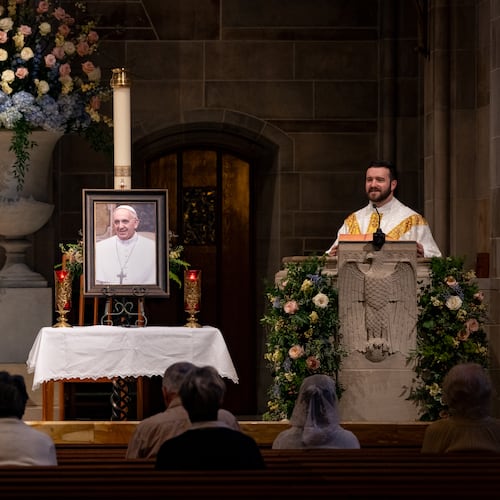Off the top of her head, Jill Alikonis can tell you how many houses are on her street. She knows how many voters live in them. And she knows the number of people who had been removed from the voter rolls in recent years and had to re-register before the November election (it’s six).
Alikonis and a team of neighbors in Westview — a historic and predominantly Black intown Atlanta neighborhood — set out two years ago with a goal of knocking on every door, registering Westview’s residents to vote and equipping them with the information they need to cast their ballot.
“The magic phrase is, ‘I’m your neighbor.’ It’s probably one of the first things I say,” said Alikonis, a 13-year Westview resident who helped start the non-partisan Westview Votes Committee. The team ended up canvassing over 1,000 houses in the neighborhood, located just south of I-20 on Atlanta’s Westside.
This hyper-local and grassroots effort is a microcosm of what has happened on the statewide level in the last four years as one million new Georgia voters were added to the rolls since 2016.
An Atlanta Journal-Constitution analysis of precinct-level election data sheds more light on the impact new voter registrations in Georgia’s heavily Democratic urban core had on the outcome of the presidential election.
Nationally, majority-Black city centers like Detroit, Philadelphia and Atlanta have been credited with helping to deliver Biden victories in their states by adding to Democratic gains in the suburbs. In Georgia, intown residents voted overwhelmingly for Democrat Joe Biden in November — he won precincts in some neighborhoods in southwest Atlanta, like Westview, with over 90% to 95% of the vote.
Over 110,000 additional people were registered to vote in the city between the 2016 and 2020 elections, bringing the total registered Atlanta voters to about 400,000, according to elections data from Fulton and DeKalb counties. Because Georgia’s voters do not register by party, it’s not known how many Republicans and Democrats were signed up.
But, compared to 2016, over 30,000 more ballots were cast in Atlanta this year, a 15% increase in turnout.
Meanwhile, the city’s traditionally conservative Buckhead area also saw a rise in voter registrations, with nearly 60% of voters in the Buckhead-area precincts casting ballots for Biden. In 2016, about 51% of voters in those same precincts chose Democrat Hillary Clinton.
Mirroring shifts seen in metro Atlanta’s suburbs this election cycle, some of the city’s northernmost precincts flipped from red to blue in the presidential election, though Republicans performed more strongly on some down-ballot races.
Registrations only half the battle
Thanks in part to the efforts of Alikonis’ group, the number of registered voters in the precinct that includes Westview increased by over 800 people between 2016 and 2020, according to Fulton County data.
The number of Westview residents who voted this year compared to 2016 increased by over 320 voters, a 25% uptick. Alikonis said that includes some people whose registrations had been canceled by the state. Georgia law allows election officials to flag registrations for removal after voters have sat out several elections.
The voter registration work in Westview has been replicated elsewhere in the city; Alikonis said her group trained similar factions in nearby Capitol View, Adair Park, Beecher Hills and Mozley Park. Each saw hundreds of new voters added to the rolls in the last four years, sometimes increasing the voting faction by as much as 50%.
Credit: Courtesy/Clara Green
Credit: Courtesy/Clara Green
On top of these localized efforts, larger voter engagement organizations like the New Georgia Project and the Georgia 55 Project have also been credited with getting more Georgians to the polls, especially in predominantly Black, intown communities. Their efforts have drawn criticism from some state officials. Just this week, the Georgia Secretary of State’s office announced it’s looking into allegations that groups including the New Georgia Project, Vote Forward and America Votes are trying to illegally register ineligible voters ahead of the January Senate runoffs, charges the groups have strongly denied.
Despite the emphasis voting advocates have placed on finding and registering new voters, the turnout data shows that a new registration does not always mean that person will go to the polls.
Across Atlanta, while large quantities of people were registered, not all of them cast a ballot, leading to an overall decrease in the citywide turnout percentage, from about 72% in 2016 to 60% this year.
“Folks registering to vote ... that is not the pinnacle. The pinnacle is actually getting people to the polls to actually participate,” said Tammy Greer, a political science professor at Clark Atlanta University who has studied voter engagement in metro Atlanta.
Moving forward, she said, political parties and organizations should put a greater focus on voter turnout than new registrations. In Atlanta, that especially presents an opportunity for Democrats, who will look to improve on the gains they made this year, heading into the two Senate runoff races on Jan. 5 that could decide the balance of power in the U.S. Senate.
With hundreds of their neighbors still sitting on the sidelines, local leaders know they have work to do before January.
Kimberly Scott, the chair of the Neighborhood Planning Unit that includes Westview and the West End, recently launched an advocacy campaign that will target registered voters who did not vote in November through door-to-door canvassing and transportation to the polls. The city council district she lives in saw the turnout rate drop from 53% to 36% this year compared to 2016; thousands more people became registered to vote, but the number of ballots cast only increased by about 800.
Still, Biden’s strong showing in the city only confirms its role as the “big juggernaut” for Democrats in Georgia, said Sean Calahan, the vice-chair of Fulton County Democrats. It also reaffirmed the role of Black voters in the party, who make up the majority of Atlanta’s population and voted overwhelmingly for Biden, according to exit polls.
With Georgia turning blue, “I think that Atlanta now means a whole lot more after this election that it did before,” Calahan said. “Its kind of the bastion of the Democratic Party.”
Buckhead gets bluer
Buckhead has long been seen as Atlanta’s most conservative enclave, a patch of red atop a sea of blue. But that may be changing, the data suggests. Amid a wave of new registrations there, thousands more voters went to the polls this year compared to 2016 and shifted the outcome bluer than in recent contests.
The precinct that includes the Chastain Park neighborhood, for example, voted 51% for Joe Biden. Donald Trump won that precinct by 11 points in 2016, and Mitt Romney won it by 43 points in 2012. Incumbent state Rep. Deborah Silcox, who represents much of the area, was also ousted this year by Democratic challenger Shea Roberts.
Some neighborhoods, including those off West Paces Ferry Road and Northside Drive where the Georgia Governor’s Mansion is located, still voted nearly 60% for Trump.
Lee Morris, the Fulton County commissioner who represents Buckhead and a former city councilman, said the surge in new voter registrations could be due in large part to new residents moving into the city. Morris, a Republican, said the voting shifts in Buckhead may be more about Trump than broader ideological or demographic changes.
For example, in the Buckhead precincts that flipped in Biden’s favor, Republican Sen. David Perdue outperformed Trump. In the Chastain Park district, Perdue got hundreds more votes than Democratic challenger Jon Ossoff.
“I think there was a heavy anti-Trump vote, and the question is going to be, with him not on the ballot on Jan. 5, will that help the Republicans?” said Morris, who declined to say how he voted. “But I think his impact on the Republican Party is not going to disappear on Biden’s inauguration.”
Bill Bozarth, a longtime Buckhead resident who ran for state House as an independent in 2014, said he was surprised that some of the northside precincts flipped. An influx of new apartments in the area likely diversified the voting electorate, he said, while some traditionally conservative voters may have split their tickets.
“My conclusion is that people who still consider themselves Republicans were so put off by Trump’s behavior that they decided to vote for Biden,” he said.
Newsroom data specialist Jennifer Peebles and news applications developer Emily Merwin DiRico contributed to this article.
About the Author
Keep Reading
The Latest
Featured

